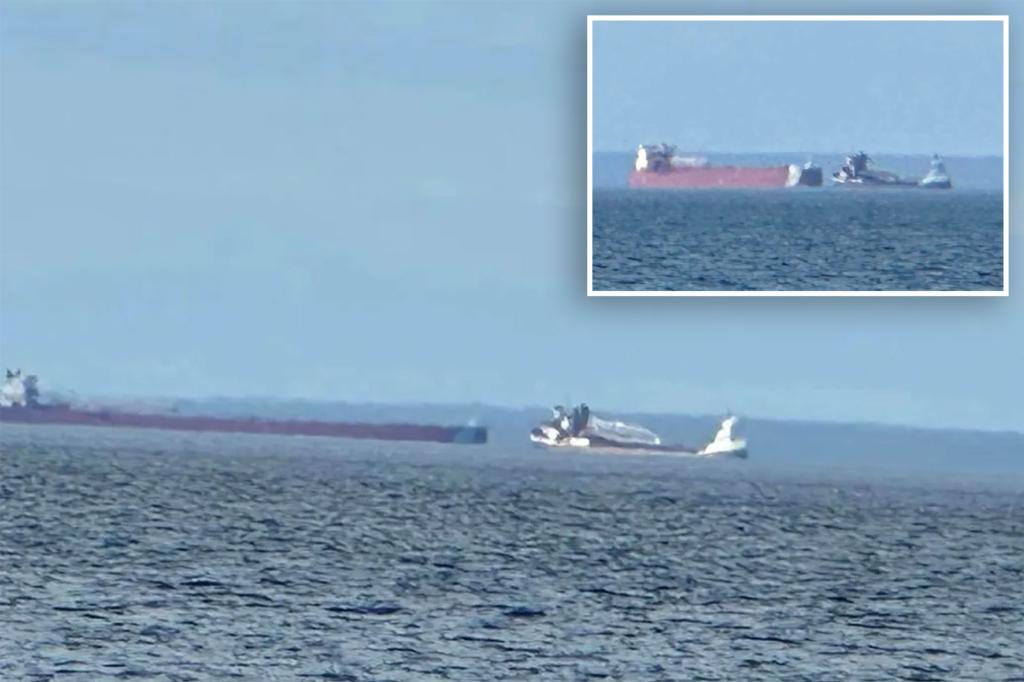A 689-foot freighter carrying taconite, a low-grade iron ore, began taking on water in Lake Superior near Grand Portage, Minnesota, after hitting an underwater obstacle. About half of the 22 people on board had to be evacuated. The ship, named Michipicoten, was located around 35 miles southwest of Isle Royale, which is part of Michigan. The incident did not result in any spills into the water, as pumps on board worked to displace the water and reduce the ship’s listing from 15 to 5 degrees. The Michipicoten was being accompanied by the bulk carrier Edwin H. Gott as it headed to port for repairs, with Coast Guard, Border Patrol, and National Park Service vessels actively involved in the situation.
The cause of the collision that led to the ship taking on water is currently under investigation. The incident took place in the northwest part of Lake Superior, which spans the US-Canadian border and is known as the largest freshwater lake in the world by surface area. The US Coast Guard is leading the response efforts, with support from Border Patrol and the National Park Service. The crew members who were not evacuated from the Michipicoten are working on board to address the situation and try to prevent further damage to the vessel. While the exact circumstances that led to the collision remain unclear, authorities are working to determine the sequence of events that caused the ship to start flooding.
The Michipicoten was being escorted by the Edwin H. Gott as it made its way towards port for necessary repairs. Despite the water intake and subsequent listing of the ship, the pumping systems on board were able to prevent any major spills into the water, minimizing the environmental impact of the incident. The cooperation between different agencies, including the Coast Guard, Border Patrol, and National Park Service, has been crucial in managing the situation and ensuring the safety of those on board the freighter. The crew members’ swift action in responding to the emergency and the support from rescue teams have played a key role in preventing a more severe outcome during this maritime incident.
As the investigation into the collision continues, authorities are working to gather information on the events leading up to the ship hitting the underwater obstacle. Understanding the factors that contributed to the incident will be essential in implementing measures to prevent similar accidents in the future. Given the location of the collision in the waters of Lake Superior, which is a shared resource between the US and Canada, cross-border cooperation may also be necessary in determining the root cause of the accident. The safety of maritime transportation in the region will be a top priority as authorities work to address the aftermath of the collision and identify any lessons learned that can help enhance safety protocols for freighters navigating the Great Lakes region.
The presence of multiple vessels from different agencies at the scene of the incident underscores the coordinated response efforts by authorities to manage the situation effectively and ensure the safety of those involved. The collaboration between the US Coast Guard, Border Patrol, and National Park Service highlights the importance of interagency cooperation in responding to maritime emergencies and mitigating potential risks. As the Michipicoten continues on its journey to port for repairs, ongoing monitoring and support from rescue teams will be critical in ensuring the ship’s stability and preventing further damage. The incident serves as a reminder of the challenges and risks associated with maritime transportation, emphasizing the need for vigilance and preparedness to address emergencies in unpredictable environments such as Lake Superior.


